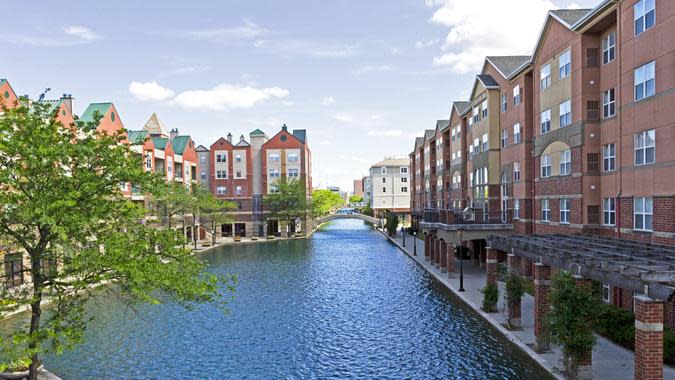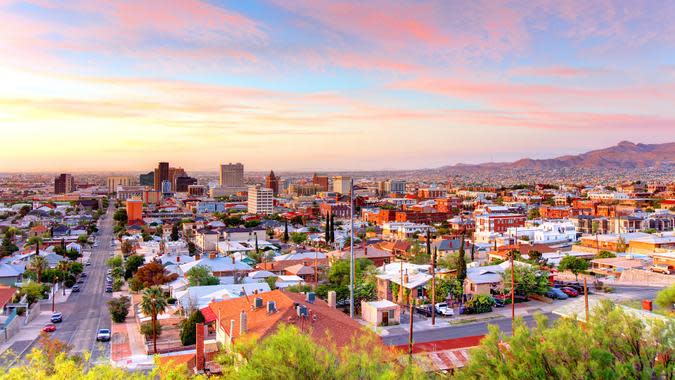Where Are the Most Affordable Big Cities To Live If You Are 65 or Older?

If you're 65 or older, lots of reasons exist to live in a big city, such as good healthcare, cultural activities, public transit and senior-centric services. The problem is that living in a big city often means higher expenses.
Social Security: Proposal for $2,400 Extra in Checks Expanded and Reintroduced in Congress
Discover: 3 Ways To Recession-Proof Your Retirement
To find the most affordable big cities in the U.S. for people 65 and older, GOBankingRates used the 2021 American Community Survey to find the 50 largest cities in terms of total households. The survey also gathered national average annual expenditures for people 65 and older from the Bureau of Labor Statistics' 2021 Consumer Expenditure Survey data and calculated each city's annual cost of necessities. Finally, the cost-of-living index for each city was sourced from Sperling's Best Places.
From the Midwest to the Deep South, here are the most affordable big cities to live in if you are 65 or older. See other affordable places to retire for you.

Detroit
Grocery Expenditures: $4,002
Housing Expenditures: $2,441
Total Annual Expenditures: $46,249
Cost-of-Living Index: 88.7
Detroit might have the highest cost-of-living index out of these affordable big cities at 88.7, but residents will save big on housing expenditures, which are 76.5% lower than the U.S. average. Additionally, utilities are 10% less than the U.S. average, grocery expenditures are 11% less and healthcare expenditures are approximately 8% lower. The city's transportation expenses are incredibly high, at a whopping 78.3% more than the U.S. average.
Take Our Poll: Would You Put All of Your Savings in an Apple Savings Account?

Columbus, Ohio
Grocery Expenditures: $4,443
Housing Expenditures: $7,333
Total Annual Expenditures: $45,050
Cost-of-Living Index: 86.4
Columbus' cost-of-living index is 86.4, which means it's 13.6% less expensive than the U.S. average. While groceries and housing are below the national average for those 65 and over, the city's annual utilities expenditures are 2.1% above the U.S. average of $4,003. However, annual transportation expenditures ($3,697) are 9.9% below the national average.

Indianapolis, Indiana
Grocery Expenditures: $4,209
Housing Expenditures: $6,513
Total Annual Expenditures: $44,268
Cost-of-Living Index: 84.9
In Indianapolis, all annual expenditures are below the U.S. average except healthcare, which is a mere 0.3% above. Housing is 37% lower than the U.S. average, while utilities are almost 10% less. That helps explain why the cost-of-living index is 84.9.

Milwaukee
Grocery Expenditures: $4,178
Housing Expenditures: $5,786
Total Annual Expenditures: $44,163
Cost-of-Living Index: 84.7
Milwaukee has an 84.7 cost-of-living index. Grocery and housing expenditures are below the national average while utilities ($3,972) and transportation ($4,189) are above.
Social Security: 20% Cuts to Your Payments May Come Sooner Than Expected

Oklahoma City, Oklahoma
Grocery Expenditures: $4,259
Housing Expenditures: $5,879
Total Annual Expenditures: $44,007
Cost-of-Living Index: 84.4
In Oklahoma City, grocery, housing, utilities and transportation expenditures are all below the U.S. average for those 65 and over. However, healthcare is 6.2% above the national average for that age group. Even so, the city has a cost-of-living index of 84.4 -- 15.6% less than the national average.

Tulsa, Oklahoma
Grocery Expenditures: $4,268
Housing Expenditures: $5,360
Total Annual Expenditures: $42,964
Cost-of-Living Index: 82.4
The cost-of-living index in Tulsa is 82.4. Although you'll pay 3.4% above the U.S. average for healthcare in Tulsa, you'll pay below the average for housing (51.6), groceries (94.9) and utilities (95.6). Aside from housing expenditures, transportation expenditures are where you'll save the most; they're about 10% lower than the national average.

El Paso, Texas
Grocery Expenditures: $4,137
Housing Expenditures: $5,775
Total Annual Expenditures: $42,756
Cost-of-Living Index: 82.0
El Paso's housing expenditures are 44.4% lower than the national average. Expenditures for groceries, healthcare, utilities and transportation are also lower than what you'll find across the nation. Those figures explain this city's cost-of-living index of 82.
Social Security: No Matter Your Age, Do Not Claim Benefits Until You Reach This Milestone

Wichita, Kansas
Grocery Expenditures: $4,272
Housing Expenditures: $5,723
Total Annual Expenditures: $42,547
Cost-of-Living Index: 81.6
Besides housing (55% of national average), transportation is one of the most affordable expenditures in Wichita, at almost 20% below the U.S. average, totaling $3,299 per year. However, utilities are 3.5% higher than the U.S. average, totaling $4,058 per year. Still, the cost-of-living index there is 81.6.

Memphis, Tennessee
Grocery Expenditures: $4,196
Housing Expenditures: $4,404
Total Annual Expenditures: $40,409
Cost-of-Living Index: 77.5
The cost-of-living index in Memphis is 77.5. Every major expenditure in this Southern state is below the U.S. average. Housing, groceries and transportation expenditures are the most affordable at 57.6%, 6.7% and 5.5% below the U.S. average, respectively.

Cleveland
Grocery Expenditures: $4,205
Housing Expenditures: $2,451
Total Annual Expenditures: $37,698
Cost-of-Living Index: 72.3
If you choose to move to Cleveland, you'll save a ton. The cost-of-living index is only 72.3. The reason is that every annual expenditure -- groceries, housing, healthcare, utilities and transportation -- is below the national average. Housing and healthcare expenditures are the most affordable, at 76.4% and 17.2% below the U.S. average, respectively.
More From GOBankingRates
Methodology: In order to find the most affordable big city in America for those 65 and over, GOBankingRates found the 50 biggest cities in terms of total households as sourced from the 2021 American Community Survey. Then GOBankingRates found the national average annual expenditures for people 65 and older, sourced from the Bureau of Labor Statistics' 2021 Consumer Expenditure Survey data. Then, GOBankingRates found each city's annual cost of necessities by adding the annual cost of groceries, housing, utilities, transportation and healthcare for people 65 and older in each state by using Sperling's Best Places cost-of-living indices for each category to factor out national estimates from the CEX. All data was collected on and up to date as of March 29, 2023.
This article originally appeared on GOBankingRates.com: Where Are the Most Affordable Big Cities To Live If You Are 65 or Older?

 Yahoo Finance
Yahoo Finance